IT Project Management: Agile and Waterfall Methodologies Comparison
VerifiedAdded on 2023/05/29
|8
|1337
|277
Report
AI Summary
This report defines project management methodologies and compares Agile and Waterfall methodologies, analysing their similarities and differences. It discusses how each methodology relates to the project life cycle, highlighting the iterative nature of Agile and the sequential approach of Waterfall. The report also examines the impact of each methodology on project phases, communication, and stakeholder involvement, with figures illustrating their respective lifecycles. This document is available on Desklib, a platform offering study tools and resources for students.
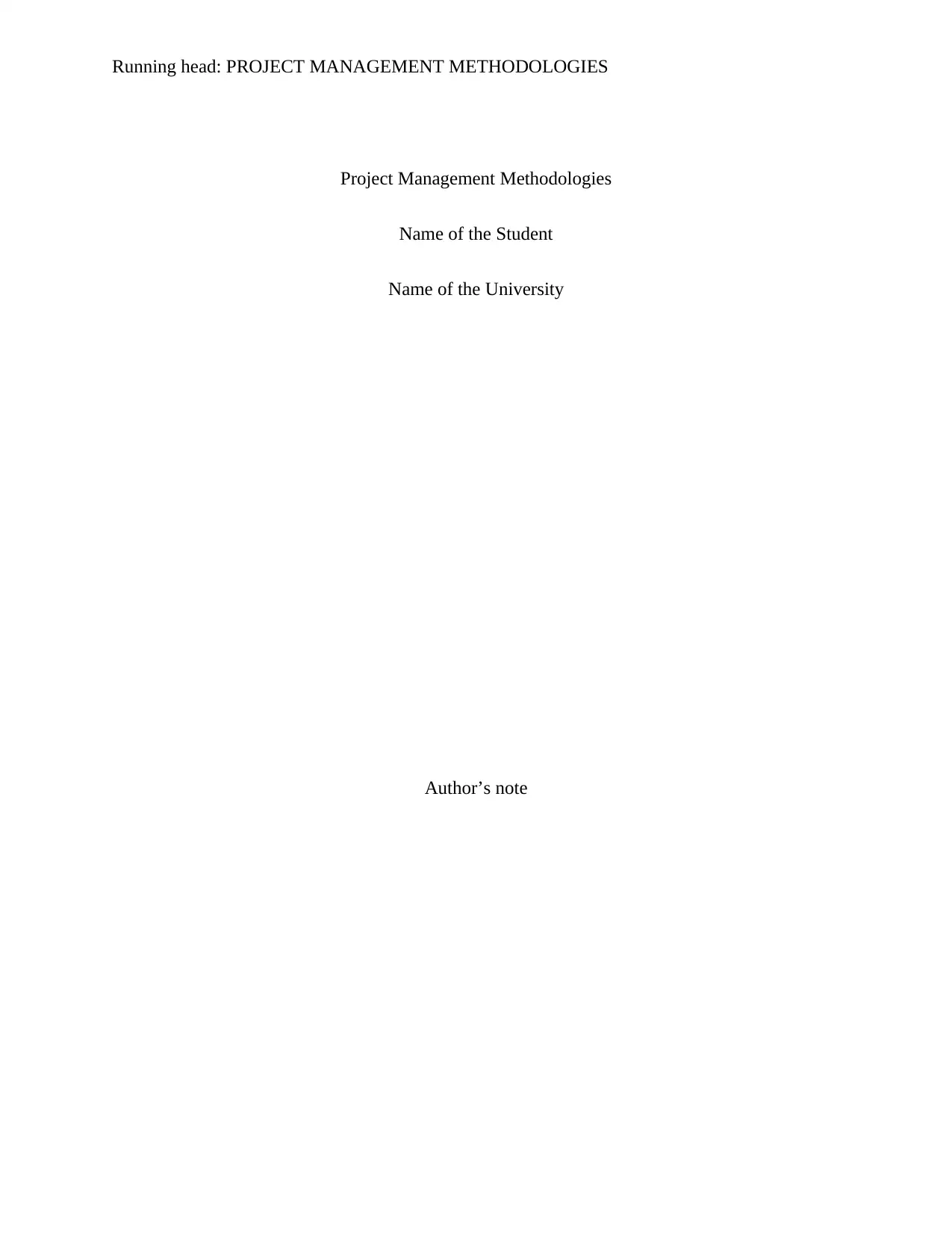
Running head: PROJECT MANAGEMENT METHODOLOGIES
Project Management Methodologies
Name of the Student
Name of the University
Author’s note
Project Management Methodologies
Name of the Student
Name of the University
Author’s note
Paraphrase This Document
Need a fresh take? Get an instant paraphrase of this document with our AI Paraphraser
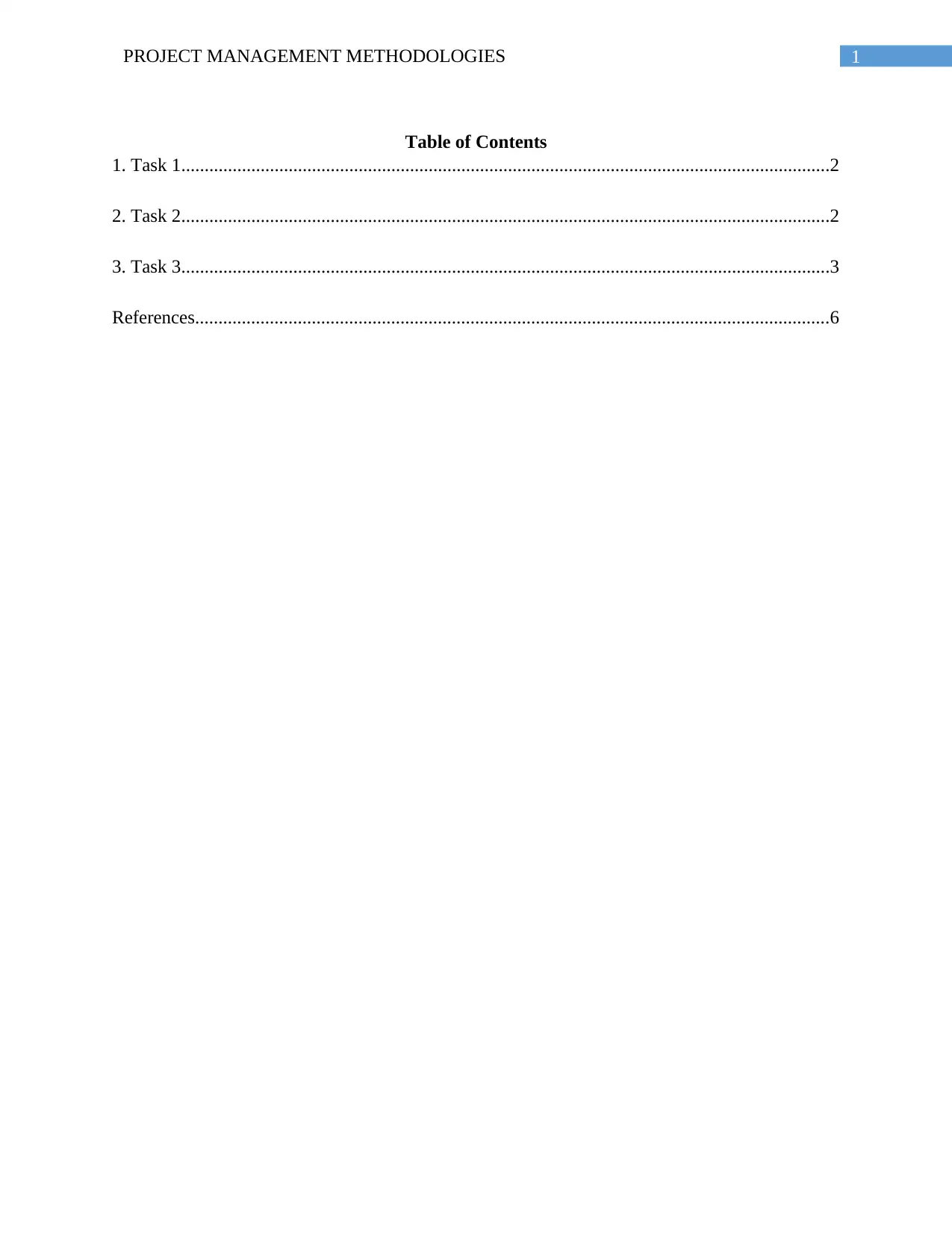
1PROJECT MANAGEMENT METHODOLOGIES
Table of Contents
1. Task 1...........................................................................................................................................2
2. Task 2...........................................................................................................................................2
3. Task 3...........................................................................................................................................3
References........................................................................................................................................6
Table of Contents
1. Task 1...........................................................................................................................................2
2. Task 2...........................................................................................................................................2
3. Task 3...........................................................................................................................................3
References........................................................................................................................................6
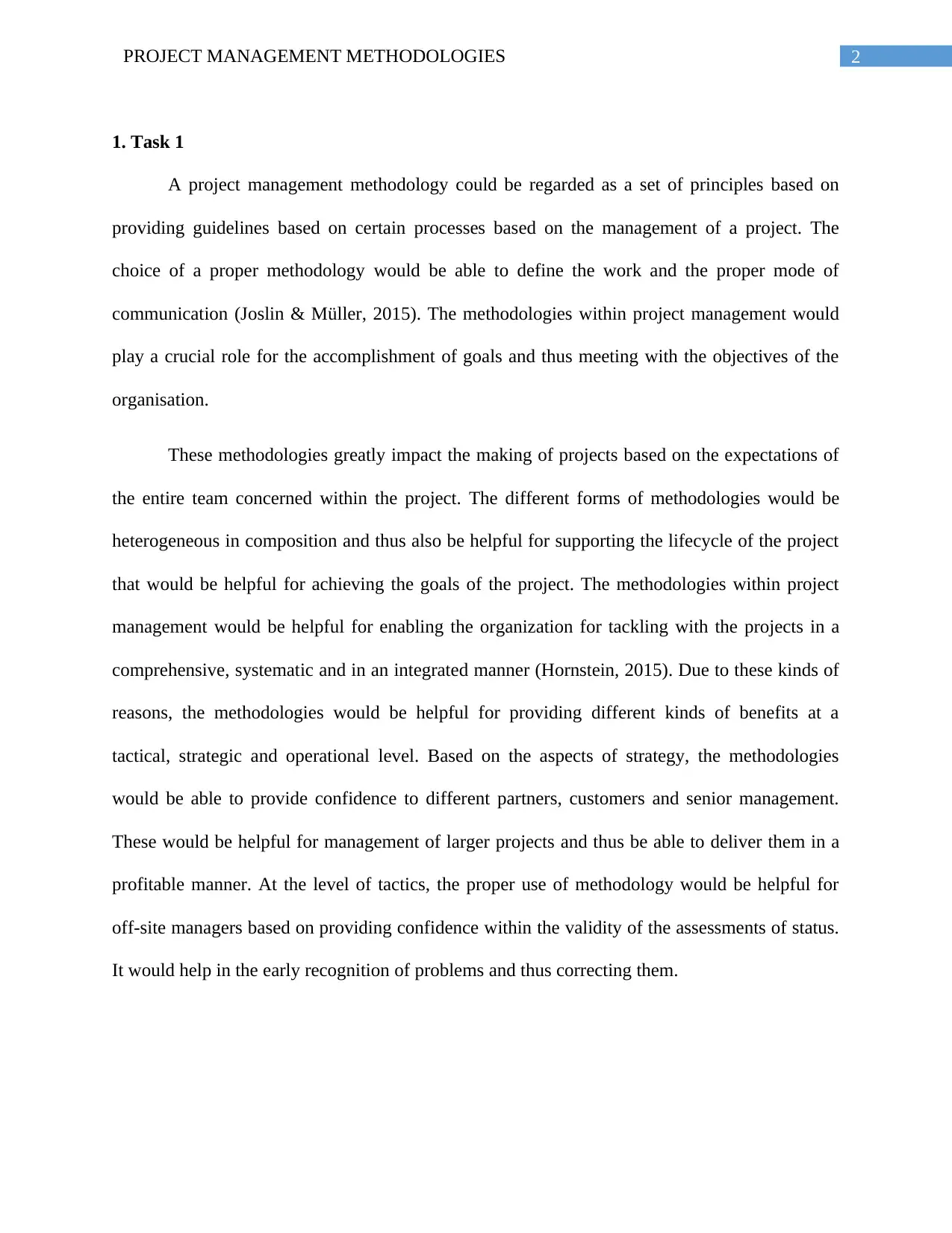
2PROJECT MANAGEMENT METHODOLOGIES
1. Task 1
A project management methodology could be regarded as a set of principles based on
providing guidelines based on certain processes based on the management of a project. The
choice of a proper methodology would be able to define the work and the proper mode of
communication (Joslin & Müller, 2015). The methodologies within project management would
play a crucial role for the accomplishment of goals and thus meeting with the objectives of the
organisation.
These methodologies greatly impact the making of projects based on the expectations of
the entire team concerned within the project. The different forms of methodologies would be
heterogeneous in composition and thus also be helpful for supporting the lifecycle of the project
that would be helpful for achieving the goals of the project. The methodologies within project
management would be helpful for enabling the organization for tackling with the projects in a
comprehensive, systematic and in an integrated manner (Hornstein, 2015). Due to these kinds of
reasons, the methodologies would be helpful for providing different kinds of benefits at a
tactical, strategic and operational level. Based on the aspects of strategy, the methodologies
would be able to provide confidence to different partners, customers and senior management.
These would be helpful for management of larger projects and thus be able to deliver them in a
profitable manner. At the level of tactics, the proper use of methodology would be helpful for
off-site managers based on providing confidence within the validity of the assessments of status.
It would help in the early recognition of problems and thus correcting them.
1. Task 1
A project management methodology could be regarded as a set of principles based on
providing guidelines based on certain processes based on the management of a project. The
choice of a proper methodology would be able to define the work and the proper mode of
communication (Joslin & Müller, 2015). The methodologies within project management would
play a crucial role for the accomplishment of goals and thus meeting with the objectives of the
organisation.
These methodologies greatly impact the making of projects based on the expectations of
the entire team concerned within the project. The different forms of methodologies would be
heterogeneous in composition and thus also be helpful for supporting the lifecycle of the project
that would be helpful for achieving the goals of the project. The methodologies within project
management would be helpful for enabling the organization for tackling with the projects in a
comprehensive, systematic and in an integrated manner (Hornstein, 2015). Due to these kinds of
reasons, the methodologies would be helpful for providing different kinds of benefits at a
tactical, strategic and operational level. Based on the aspects of strategy, the methodologies
would be able to provide confidence to different partners, customers and senior management.
These would be helpful for management of larger projects and thus be able to deliver them in a
profitable manner. At the level of tactics, the proper use of methodology would be helpful for
off-site managers based on providing confidence within the validity of the assessments of status.
It would help in the early recognition of problems and thus correcting them.
⊘ This is a preview!⊘
Do you want full access?
Subscribe today to unlock all pages.

Trusted by 1+ million students worldwide

3PROJECT MANAGEMENT METHODOLOGIES
2. Task 2
The two different types of methodologies are Agile and Waterfall Model. Based on the
processes that are served in the industries, the different kinds of similarities and dissimilarities
between these two methodologies are:
The Agile methodology separates the development of project lifecycle into sprints. In the
Waterfall Model, the process of software development is primarily divided into several distinct
phases (Serrador & Pinto, 2015). The Agile methodology follows an incremental approach while
the Waterfall model would follow a sequential process of design. Though the Agile methodology
is known for its flexibility, the Waterfall model would be structured so that this process would be
rigid (Palmquist et al., 2013). Although, Agile methodology could be considered as a collection
of different projects, the Waterfall model could be helpful for the completion of a single project.
Agile methodology is defined as a flexible method that would allow for making of changes
within the requirements of the development of the project. This would also be done even if the
initial planning would also be completed. In the Waterfall model, all the development of the
project such as designing, development and testing would be completed once within the model
(Joslin & Müller, 2015). The Agile development could be defined as a process in which the
different requirements would be expected for change and evolvement. In the Waterfall model,
the different projects would have definite requirements and the changes would not be expected.
3. Task 3
The Agile methodology has sequential form of project phases, which are known as
iterations (Abrahamsson et al., 2017). The Agile SDLC model could be defined as the
combination of incremental and iterative process models based on focusing on the adaptability of
processes and providing satisfaction of customers based on rapid delivery of working with the
2. Task 2
The two different types of methodologies are Agile and Waterfall Model. Based on the
processes that are served in the industries, the different kinds of similarities and dissimilarities
between these two methodologies are:
The Agile methodology separates the development of project lifecycle into sprints. In the
Waterfall Model, the process of software development is primarily divided into several distinct
phases (Serrador & Pinto, 2015). The Agile methodology follows an incremental approach while
the Waterfall model would follow a sequential process of design. Though the Agile methodology
is known for its flexibility, the Waterfall model would be structured so that this process would be
rigid (Palmquist et al., 2013). Although, Agile methodology could be considered as a collection
of different projects, the Waterfall model could be helpful for the completion of a single project.
Agile methodology is defined as a flexible method that would allow for making of changes
within the requirements of the development of the project. This would also be done even if the
initial planning would also be completed. In the Waterfall model, all the development of the
project such as designing, development and testing would be completed once within the model
(Joslin & Müller, 2015). The Agile development could be defined as a process in which the
different requirements would be expected for change and evolvement. In the Waterfall model,
the different projects would have definite requirements and the changes would not be expected.
3. Task 3
The Agile methodology has sequential form of project phases, which are known as
iterations (Abrahamsson et al., 2017). The Agile SDLC model could be defined as the
combination of incremental and iterative process models based on focusing on the adaptability of
processes and providing satisfaction of customers based on rapid delivery of working with the
Paraphrase This Document
Need a fresh take? Get an instant paraphrase of this document with our AI Paraphraser
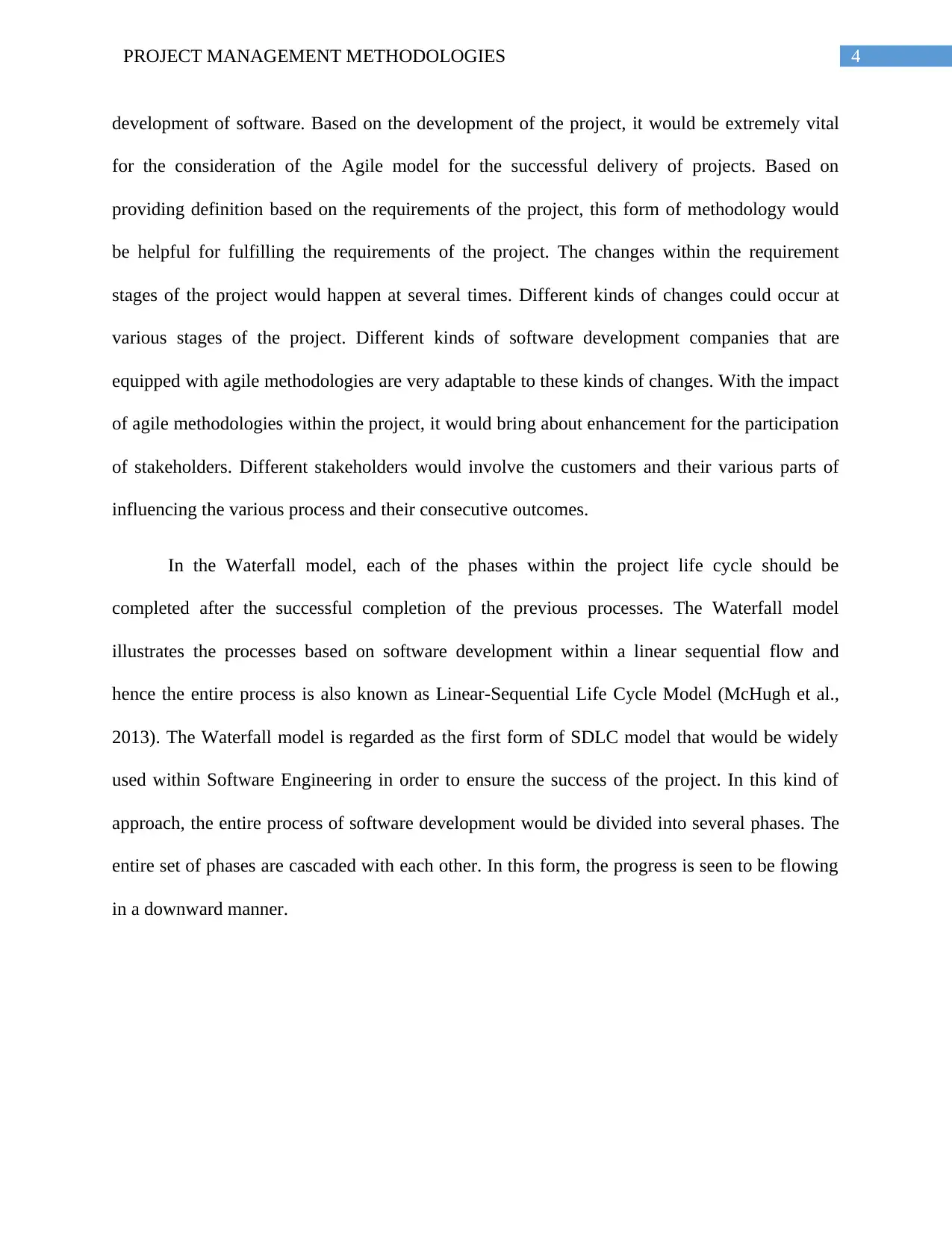
4PROJECT MANAGEMENT METHODOLOGIES
development of software. Based on the development of the project, it would be extremely vital
for the consideration of the Agile model for the successful delivery of projects. Based on
providing definition based on the requirements of the project, this form of methodology would
be helpful for fulfilling the requirements of the project. The changes within the requirement
stages of the project would happen at several times. Different kinds of changes could occur at
various stages of the project. Different kinds of software development companies that are
equipped with agile methodologies are very adaptable to these kinds of changes. With the impact
of agile methodologies within the project, it would bring about enhancement for the participation
of stakeholders. Different stakeholders would involve the customers and their various parts of
influencing the various process and their consecutive outcomes.
In the Waterfall model, each of the phases within the project life cycle should be
completed after the successful completion of the previous processes. The Waterfall model
illustrates the processes based on software development within a linear sequential flow and
hence the entire process is also known as Linear-Sequential Life Cycle Model (McHugh et al.,
2013). The Waterfall model is regarded as the first form of SDLC model that would be widely
used within Software Engineering in order to ensure the success of the project. In this kind of
approach, the entire process of software development would be divided into several phases. The
entire set of phases are cascaded with each other. In this form, the progress is seen to be flowing
in a downward manner.
development of software. Based on the development of the project, it would be extremely vital
for the consideration of the Agile model for the successful delivery of projects. Based on
providing definition based on the requirements of the project, this form of methodology would
be helpful for fulfilling the requirements of the project. The changes within the requirement
stages of the project would happen at several times. Different kinds of changes could occur at
various stages of the project. Different kinds of software development companies that are
equipped with agile methodologies are very adaptable to these kinds of changes. With the impact
of agile methodologies within the project, it would bring about enhancement for the participation
of stakeholders. Different stakeholders would involve the customers and their various parts of
influencing the various process and their consecutive outcomes.
In the Waterfall model, each of the phases within the project life cycle should be
completed after the successful completion of the previous processes. The Waterfall model
illustrates the processes based on software development within a linear sequential flow and
hence the entire process is also known as Linear-Sequential Life Cycle Model (McHugh et al.,
2013). The Waterfall model is regarded as the first form of SDLC model that would be widely
used within Software Engineering in order to ensure the success of the project. In this kind of
approach, the entire process of software development would be divided into several phases. The
entire set of phases are cascaded with each other. In this form, the progress is seen to be flowing
in a downward manner.
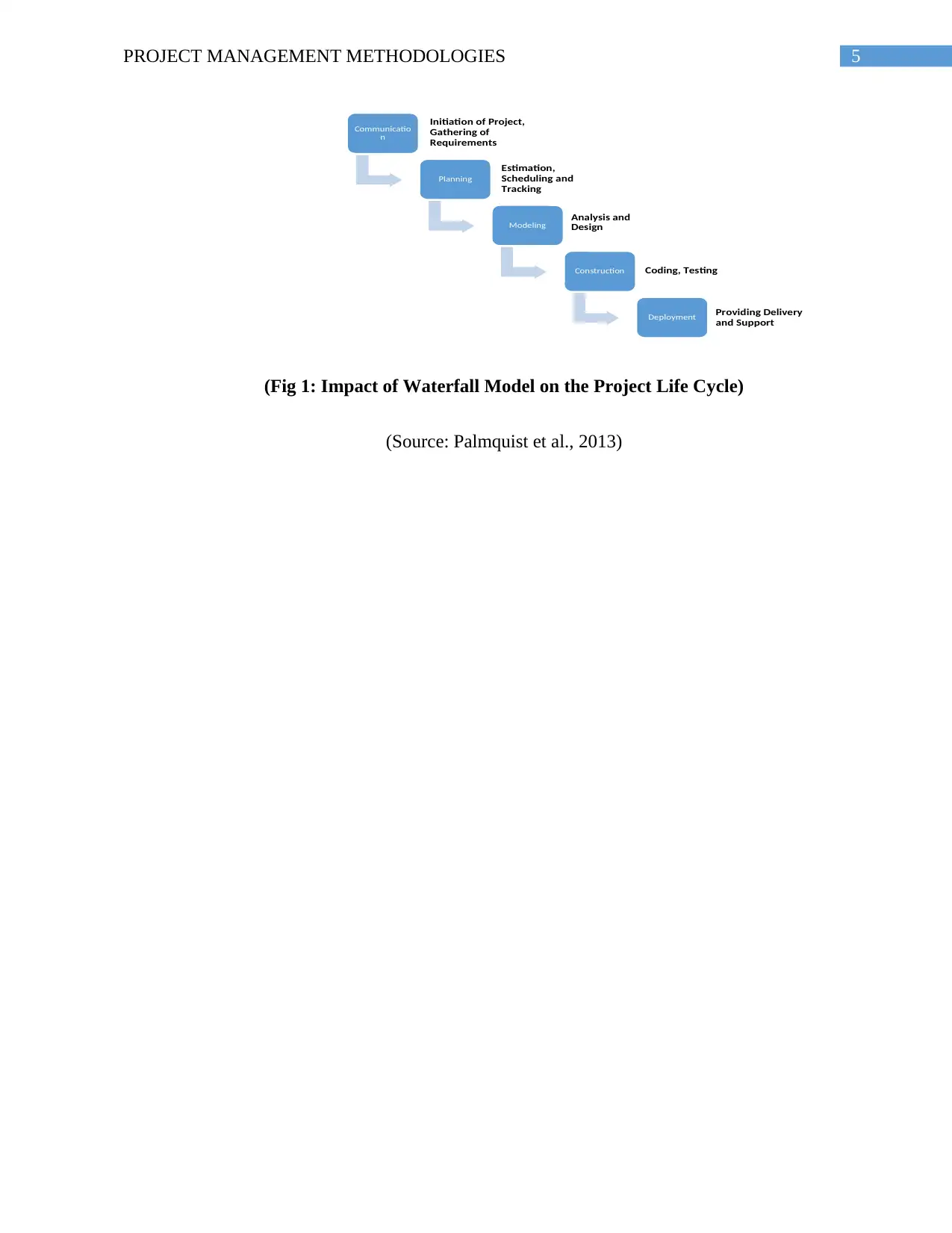
5PROJECT MANAGEMENT METHODOLOGIES
(Fig 1: Impact of Waterfall Model on the Project Life Cycle)
(Source: Palmquist et al., 2013)
Communicatio
n
Initiation of Project,
Gathering of
Requirements
Planning
Estimation,
Scheduling and
Tracking
Modeling Analysis and
Design
Construction
Providing Delivery
and Support
Deployment
Coding, Testing
(Fig 1: Impact of Waterfall Model on the Project Life Cycle)
(Source: Palmquist et al., 2013)
Communicatio
n
Initiation of Project,
Gathering of
Requirements
Planning
Estimation,
Scheduling and
Tracking
Modeling Analysis and
Design
Construction
Providing Delivery
and Support
Deployment
Coding, Testing
⊘ This is a preview!⊘
Do you want full access?
Subscribe today to unlock all pages.

Trusted by 1+ million students worldwide
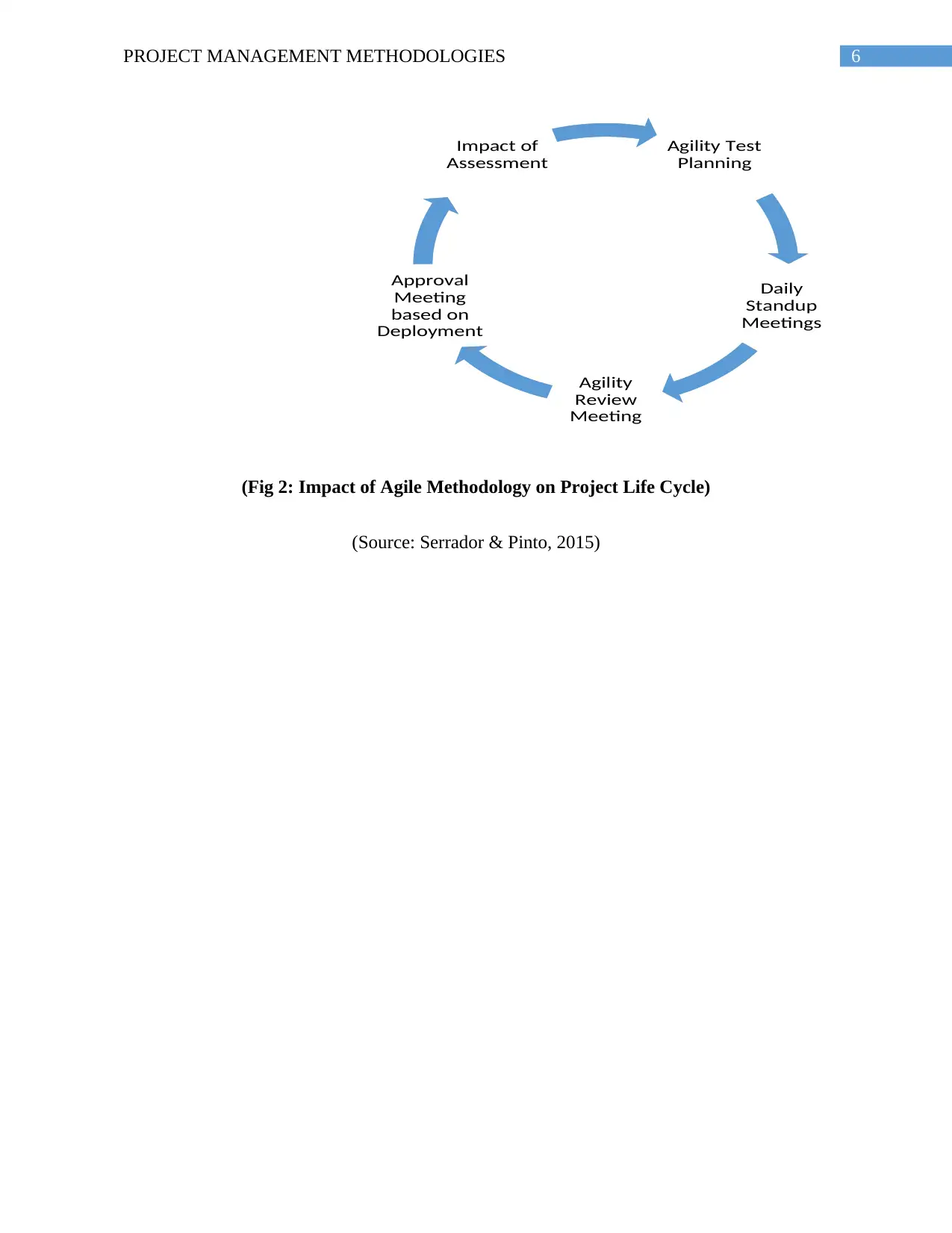
6PROJECT MANAGEMENT METHODOLOGIES
(Fig 2: Impact of Agile Methodology on Project Life Cycle)
(Source: Serrador & Pinto, 2015)
Agility Test
Planning
Daily
Standup
Meetings
Agility
Review
Meeting
Approval
Meeting
based on
Deployment
Impact of
Assessment
(Fig 2: Impact of Agile Methodology on Project Life Cycle)
(Source: Serrador & Pinto, 2015)
Agility Test
Planning
Daily
Standup
Meetings
Agility
Review
Meeting
Approval
Meeting
based on
Deployment
Impact of
Assessment
Paraphrase This Document
Need a fresh take? Get an instant paraphrase of this document with our AI Paraphraser
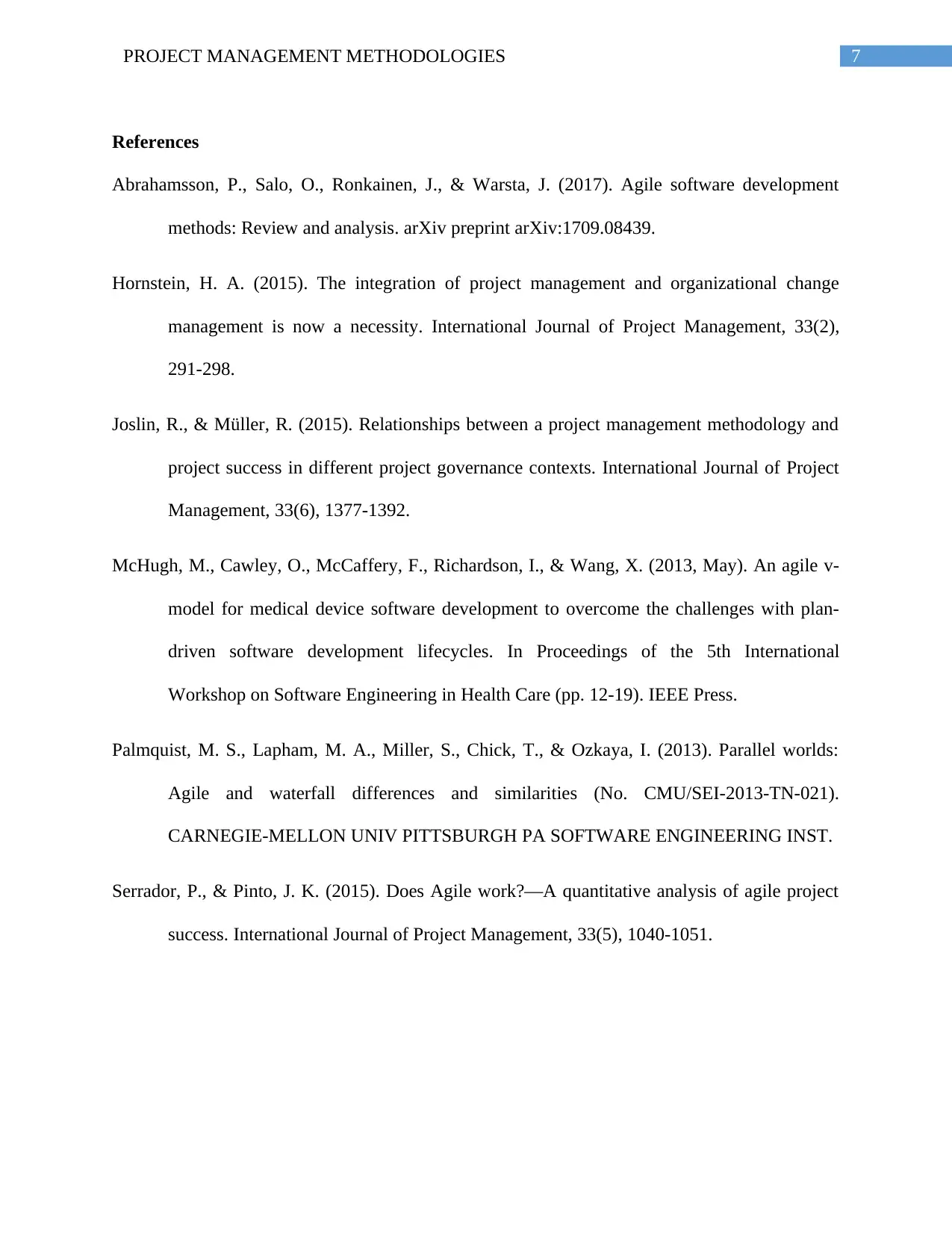
7PROJECT MANAGEMENT METHODOLOGIES
References
Abrahamsson, P., Salo, O., Ronkainen, J., & Warsta, J. (2017). Agile software development
methods: Review and analysis. arXiv preprint arXiv:1709.08439.
Hornstein, H. A. (2015). The integration of project management and organizational change
management is now a necessity. International Journal of Project Management, 33(2),
291-298.
Joslin, R., & Müller, R. (2015). Relationships between a project management methodology and
project success in different project governance contexts. International Journal of Project
Management, 33(6), 1377-1392.
McHugh, M., Cawley, O., McCaffery, F., Richardson, I., & Wang, X. (2013, May). An agile v-
model for medical device software development to overcome the challenges with plan-
driven software development lifecycles. In Proceedings of the 5th International
Workshop on Software Engineering in Health Care (pp. 12-19). IEEE Press.
Palmquist, M. S., Lapham, M. A., Miller, S., Chick, T., & Ozkaya, I. (2013). Parallel worlds:
Agile and waterfall differences and similarities (No. CMU/SEI-2013-TN-021).
CARNEGIE-MELLON UNIV PITTSBURGH PA SOFTWARE ENGINEERING INST.
Serrador, P., & Pinto, J. K. (2015). Does Agile work?—A quantitative analysis of agile project
success. International Journal of Project Management, 33(5), 1040-1051.
References
Abrahamsson, P., Salo, O., Ronkainen, J., & Warsta, J. (2017). Agile software development
methods: Review and analysis. arXiv preprint arXiv:1709.08439.
Hornstein, H. A. (2015). The integration of project management and organizational change
management is now a necessity. International Journal of Project Management, 33(2),
291-298.
Joslin, R., & Müller, R. (2015). Relationships between a project management methodology and
project success in different project governance contexts. International Journal of Project
Management, 33(6), 1377-1392.
McHugh, M., Cawley, O., McCaffery, F., Richardson, I., & Wang, X. (2013, May). An agile v-
model for medical device software development to overcome the challenges with plan-
driven software development lifecycles. In Proceedings of the 5th International
Workshop on Software Engineering in Health Care (pp. 12-19). IEEE Press.
Palmquist, M. S., Lapham, M. A., Miller, S., Chick, T., & Ozkaya, I. (2013). Parallel worlds:
Agile and waterfall differences and similarities (No. CMU/SEI-2013-TN-021).
CARNEGIE-MELLON UNIV PITTSBURGH PA SOFTWARE ENGINEERING INST.
Serrador, P., & Pinto, J. K. (2015). Does Agile work?—A quantitative analysis of agile project
success. International Journal of Project Management, 33(5), 1040-1051.
1 out of 8
Related Documents
Your All-in-One AI-Powered Toolkit for Academic Success.
+13062052269
info@desklib.com
Available 24*7 on WhatsApp / Email
![[object Object]](/_next/static/media/star-bottom.7253800d.svg)
Unlock your academic potential
Copyright © 2020–2025 A2Z Services. All Rights Reserved. Developed and managed by ZUCOL.

